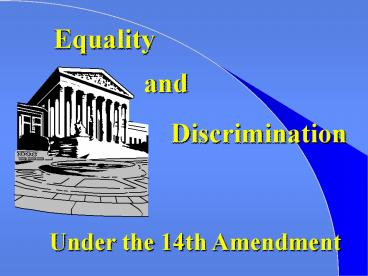Discrimination - PowerPoint PPT Presentation
1 / 22
Title:
Discrimination
Description:
Desegregation must proceed with 'all deliberate speed' Heart ... de jure discrimination. Racial segregation that results from government. (e.g. Jim Crow Laws) ... – PowerPoint PPT presentation
Number of Views:65
Avg rating:3.0/5.0
Title: Discrimination
1
Equality
and
Discrimination
Under the 14th Amendment
2
Protected Classes Under the 14th Amendment
Protected Category Statutorily Established 1.
Age 2. Sexual Orientation
3
Racial Justice
4
Racial Justice
5
Racial Justice
Firefighters Local Union v. Stotts (1984) Ruled
that affirmative action plans and minority
employee protection plans do not override valid
seniority systems.
Jones v. Mayer Co. (1968) Supported the 1866
Civil Rights Act which banned private acts of
discrimination under the 13th Amendment which had
abolished slavery. Discrimination was held to
create a badge of slavery.
6
Racial Justice
7
Civil Rights Legislation
TITLE VI Federal dollars spent under any grant
program must be withdrawn from an entire school
or institution of higher learning that
discriminates on the ground of race, color, or
national origin.
TITLE II Criminal offense to discriminate against
a customer or patrons in a place of public
accommodation because of race, color, religion or
national origin.
8
Civil Rights Legislation
TITLE IX The federal government could withhold
funding from any educational institution that was
guilty of sex discrimination.
TITLE VII Age, sex, or handicaps are added as
classes suspect of discrimination to employment.
9
KERNER COMMISSION
Called by President Johnson in 1968 and chaired
by Gov. Otto Kerner of Illinois to study race
relations, the following results were reported
White society condones racism
The U.S. is moving toward two societies one
black and the other white
As conditions improve, discontent with racism
grows
10
Kerner Commission Recommendations
Creation of additional jobs by government and
private industry
On-the-job training, partly subsidized by
government, for the hard-core unemployed
Increased efforts to eliminate de facto school
segregation and to improve schools serving
disadvantaged youth
Public welfare improvements such as federally
funded higher payments to the needy and
measures to keep black families together
6 million units of decent housing for low and
moderate income families
11
de facto discrimination Racial segregation that
results from actions of individuals rather than
the government. (e.g. housing discrimination)
de jure discrimination Racial segregation that
results from government. (e.g. Jim Crow Laws)
12
Affirmative Action
Programs designed to take positive actions to
increase the number of women and minorities in
jobs and educational programs.
Quotas - judicial remedies for failure by
employers or educational institutions to
implement affirmative action plans.
Reverse Discrimination - laws and policies that
discriminate against whites, especially white
males.
Proposition 209 - California referendum ending
all affirmative action programs in the state.
13
(No Transcript)
14
(No Transcript)
15
(No Transcript)
16
E q u a l i t y
. . . of opportunity holds the greatest
consensus . . . of starting conditions is
exemplified with programs such as Head Start . .
. of results is most likely to be supported by
socialists
17
Amendments Guaranteeing Equality
14th - Equal Protection under the Law
20th - Women Suffrage
24th - No Poll Taxes
26th - 18 Year Old Right to Vote
18
Korematsu v. United States Evacuation of Japanese
American from the West Coast was constitutional
under the war powers granted to Congress and the
President by the Constitution.
Illegal Immigration Restrictions Act of
1966 Deportation of undocumented aliens became
easier, prohibited undocumented aliens from
receiving various government benefits.
19
Equal Rights Amendment Would provide
Constitutional protection for women rather than
statutory protection.
Equal Employment Opportunity Commission
(EEOC) Established under Title VII of the Civil
Rights Act of 1964 to enforce the act.
20
Age Discrimination in Employment Act (1967
1978) Prohibits job discrimination against
workers 40 to 65 years old Changed the
compulsory retirement age to 70, although it
has since been eliminated
Education of All Handicapped Children
Act (1975) Entitles all children, regardless of
disability, to an education in the least
restrictive environment at public expense.
21
Americans with Disabilities Act of 1990
Prohibits discrimination in employment
because of a disability Requires businesses
and public agencies to make facilities
accessible to those with disabilities
Requires employers to make reasonable
accommodations to employees and potential
employees disabilities.
22
Civil Rights and Womens Equity in Employment Act
of 1991 Requires proof from employers that any
differences in hiring and promotion are because
of the requirements of the job.
Family and Medical Leave Act of 1993 Requires
employers of 50 or more workers to grant up to 12
weeks of unpaid leave for the birth or adoption
of a child or the illness of a close family
member a man or woman may request the leave.































